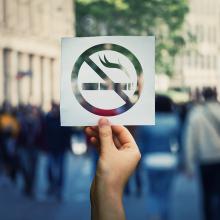Commercial Tobacco Prevention and Treatment Program: Health Equity
Tobacco is the largest cause of preventable death and disease in Wisconsin and the United States. Over past decades, the Wisconsin Commercial Tobacco Prevention and Treatment Program (CTPTP), together with local coalitions, statewide partners, and state leaders, has helped greatly reduce the negative health consequences of commercial tobacco in Wisconsin. However, not all Wisconsinites share in these beneficial changes. Addressing this unfair difference in health outcomes is a priority of the CTPTP.
We strive to improve social determinants of health in Wisconsin to reduce health disparities and promote health equity.
Social determinants of health
Social determinants of health are nonmedical factors that affect a person’s health. They are the conditions into which people are born, grow, work, live, and age. Some social determinants of tobacco-related disease include:
- The number and location of local tobacco and vape retailers.
- The strength of smoke- and vapor-free air policies.
- The availability of tobacco and nicotine quit services.
Health disparities
Health disparities prevent people from living their healthiest possible lives. Socially disadvantaged groups experience health disparities when they are unequally burdened by disease, injury, and violence. Commercial tobacco and nicotine disparately burden people of color, American Indians, people with low incomes or educational attainment, LGBTQ+ persons, and those in mental health or substance use treatment, among other groups.
Health equity
Health equity means that everyone has a fair and just opportunity to be as healthy as possible. This requires removing obstacles to good health, such as poverty and discrimination. The CTPTP focuses on helping disparately targeted people overcome tobacco and nicotine addiction. We also work to help people protect their communities from the predatory marketing tactics of the commercial tobacco industry.
Industry targeting
Industry targeting is designed to produce health disparities, as best explained in the words of the tobacco industry itself:
"Clearly, the sole reason for [our] interest in the black and Hispanic communities is the actual and potential sales of products... However, this relatively small and often tightly knit community can work to [our] marking advantage, if exploited properly. Peer pressure plays a more important role in many phases of life in the minority community. Therefore, dominance of the marketplace and the community environment is essential to successfully increase sales."
—Brown & Williamson Total Minority Marketing
Traditional and sacred tobacco
Traditional tobacco is and has been used in ceremonial ways by American Indians for thousands of years.
Uplifting the different practices around traditional tobacco is essential to commercial tobacco prevention and control efforts. It allows us to build a strong foundation when working with sovereign native communities.
As sovereign nations, native tribes maintain a government-to-government relationship with the state of Wisconsin that is essential to this work.
Commercial tobacco
- Corrupts the sacred meaning of the traditional tobacco plant with commercial tactics
- Sold for recreational use
- Causes death and disease
- Contains harmful chemical additives
- Exploits American Indian culture for profit
Traditional tobacco
- Offered as a spiritual gift to express gratitude; as a sign of respect; and to ask for prayers, advice, or blessings
- Offered in prayer to the Creator
- Heals mind, body, and spirit
- Cleanses, purifies, and blesses
- Has a rich history within Native communities
The word "tobacco" on this page refers to commercial tobacco, not traditional Native American tobacco.
Traditional tobacco: a sacred medicine for healing; offerings to the Creator; and spiritual gifts to express gratitude, show respect, and ask for prayers or advice. Commercial tobacco ("tobacco"): a corruption of traditional tobacco into dangerous recreational commodities like cigarettes, vapes, and chewing tobacco.
Populations of focus
Wisconsin's Commercial Tobacco Prevention and Treatment Program (CTPTP) is focused on decreasing rates of disease among people who are especially impacted by commercial tobacco. Community engagement at the grassroots level helps usher in policy change and impacts social norms around commercial tobacco and nicotine. CTPTP works with people and communities where the need and potential impact are greatest. These populations include:
African Americans
Studies show there is up to 10 times more tobacco marketing in Black neighborhoods than other neighborhoods. Menthol cigarettes, little cigars and cigarillos are the most heavily marketed and sold products in communities of color.
Up Close with Tobacco and African Americans, P-02681c (PDF)
American Indians
The tobacco industry has intentionally appropriated native cultures and traditional tobacco to target tribes for profit. This exploitation has caused Native American Wisconsinites to suffer the highest burden of commercial tobacco-related disease in Wisconsin.
Up Close with Tobacco and American Indians, P-02681 (PDF)
LGBTQ+ persons
People who identify as lesbian, gay, bisexual, transgender, and/or queer (LGBTQ+) have been aggressively targeted by the tobacco industry. LGBTQ+ communities have a higher prevalence of tobacco and nicotine use than their non-sexual/gender-marginalized peers.
Up Close with Tobacco and LGBTQ+ Communities, P-02682a (PDF)
People of low socioeconomic status (SES)
Low-SES smokers smoke or vape earlier in life, more heavily, and for a longer time because of things like tobacco-industry pressure, stress, less access to health care, and cultural normalization.
Up Close with Tobacco and Socioeconomic Status, P-02681b (PDF)
People with behavioral health concerns
Those coping with a behavioral health challenge, substance use disorder, or both, make up about 25% of the population, but consume 40% of all purchased cigarettes. Over half of the clients in Wisconsin Community Support Programs that treat people with persistent mental illness currently smoke or vape.
Up Close with Tobacco and Behavioral Health, P-02681d (PDF)
Get free help to quit commercial tobacco and nicotine
Wisconsin Tobacco Quit Line
Customized plans and coaching
Ages 13+
800-Quit-Now
Text "READY" to 34191
WI Tobacco Quit Line
Live Vape Free
Text support to quit e-cigarettes
Ages 13-26
Text "VAPEFREE" to 873373
Live Vape Free
American Indian Quit Line
Culturally tailored coaching
Ages 18+
888-7Ai-Quit
American Indian Quit Line
First Breath
Support during and after pregnancy
Ages 18+
First Breath






